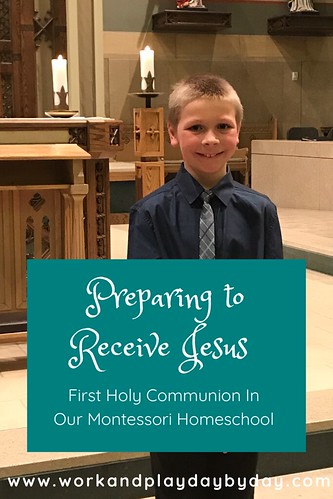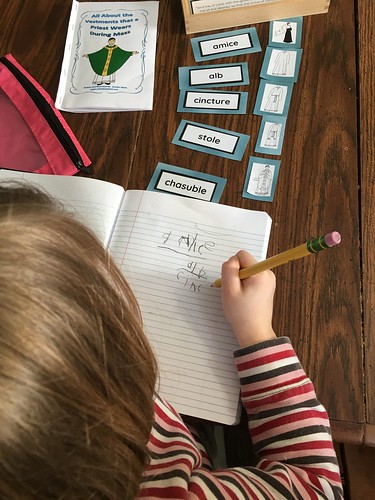In the last week the children go into retreat for five days before their first Communion…They live apart from their companions, and a portion of the garden is set aside and reserved for them. This isolation is, however, neither sad nor wearisome, for innumerable proofs of love reach the small solitaries. The older boys in the school give all their attention to the preparation for the solemn Mass…and the music being practiced in their honor sweetly reaches the ears of the future communicants. During retreat, the children laugh and work. … They pass the greater part of the time in the garden, looking after the plants and the animals. Manual work consists in making their own silver rosaries which they will use on their first Communion day. … Physical exercises suited to the ocasion consist in practicing standing up and siting down, walking without knocking against people or objects, genuflecting, kneeling down and rising up, in observing silence, in maintaining dignity, in not turing at noise. This occupation of the heart consists in raising their thoughts to God at every action during the day, in loving and praising Him.
Can you even imagine having this experience of spiritual beauty at the age of 6 or 7? In a collection of essays, titled The Child in the Church, Maria Montessori describes this model of sacramental preparation, culminating in a week long retreat for students receiving their First Holy Communion.
As an educator, a Catholic, and a parent this approach towards the religious education of children has admittedly captured my heart.
And I’m not alone. In fact, in the years since the Montessori method was founded (both before and after Maria Montessori’s death) an entire system called Catechesis of the Good Shepherd has developed as a way of training religious education teachers in the methods of Maria Montessori as they apply to spiritual formation and our Catholic faith.
Which is lovely, except I don’t live somewhere with an atrium. And even in the atrium, we are talking about something different than what is described above. Even the most “hands-on” sacramental preparation programs have fallen short in my opinion on embracing the beauty and the truths of the Catholic faith.
So I did what I always do. I studied Montessori’s thoughts on religious education (resources at the end of this post). I studied a bunch of traditional parish-based and homeschool programs to see what they cover.
And I made my own way.
For each child, my method has gotten a bit more refined as my studies have grown but this year was particularly beautiful as Logan prepared for his First Holy Communion through his other studies rather than in addition to.
What We Studied
Note, this post does not include any work we did for First Reconcilliation or even every resource we used for First Communion, rather the topics studied and a few ideas for how you can incorporate them on your own. It assumes that a child is already familiar with basic Catholic prayers, attends Mass regularly, and has been taught about the true presence. Those things should absolutely not be introduced for the first time in a sacramental year. This outline is not meant as a stand-alone sacramental prep curriculum. Please check with your parish for local requirements.
The Liturgical Year
At the start of Lent, we began preparing for First Holy Communion in a special way. We have a liturgical shelf in our school area and it was stripped empty to build anticipation for the work that would be added in the coming weeks- the final weeks of preparation. Using the Circle of The Church Year, we reviewed the seasons of the church year and liturgical colors.
Preparing for Mass
From the liturgical seasons and colors, we looked to the ways these materials are used within the church and in the preparation the priest goes through prior to Mass. For this we did a pasting activity to review liturgical vestments, along with studying the free resources from Catholic Inspired.
In addition to studying things that the priest does to prepare for Mass, we also did a ton of practical life related to the duties of a sacristan. Ironing altar linens, lighting candles, polishing, etc.
The Mass
From preparing for Mass, we studied the parts of Mass focusing specifically on the Liturgy of the Eucharist. For this, I put together two shelf works.
Using a Mass kit from Almond Rod Toys (available on Etsy) and altar linens sewn by Kylee (age 10), we created a complete Mass set. We supplemented this with our own labeling cards and definitions (shown in the top post image).
I also put together a biblical story telling set for the Last Supper. Rather than a formal lesson, I simply told the story from one of our Children’s Bibles and let the children draw their own connections. I knew this was a good call when someone ran away in the middle of the story to get the chalice and hosts from our Mass kit!
Throughout the season of Lent, I did not ask Logan to do any reading or copy work of my choosing. Instead, I encouraged him to practice with the cardwork that was laid out to accompany the above works. It was interesting to see how he practiced certain concepts again and again, while others he left almost completely alone. I cannot peek into his brain to know what drew him to specific concepts, but I am content to simply observe what was. I’m confident he learned most deply that which he felt most likely to be useful to him in the future.
We did participate in our parish-based sacramental preparation as well, even though they did not require it. In the past, we have gone both ways with this but this year’s commitment was only one Wednesday per month in a parent:child setting with a catechist we all adore. The curriculum wasn’t what I would have chosen (frankly there isn’t one I would have chosen!), but I don’t believe that every learning opportunity has to be perfect to be productive.
“Yes, of course, I would have certain things learned by heart; but I would have the memorizing come at the end, as a summing up after the experience.“
-Maria Montessori (The Child in the Church)
Want to Go Deeper?
You are in luck! You can dive deeper into this concept today!
First of all, I put together a printable bundle with all of the files I created for myself. The vestment prayers and labels, the vestment templates, and the altar setting pieces and definitions. The file also contains a couple other links included in this post and suggested other field trips and practical life. You can purchase the file in my store or on Teachers Pay Teachers.
OR! If you want to get this file for free, head on over to my store and join our Premium Member Content Group. This file is already uploaded to the group, along with a video walk through of our catechesis shelf from this unit! There are also a ton of other resources (Montessori, Classical, Hands On Catechesis, and More!) exclusively available to members. Plus you get a forum to pick my brain in real time with any questions that come up!
And to make it even better- I’m having a membership flash sale! 50% off New Premium Content Membership through May 15th with the code NEWMEMBER50
Additional Resoures Available on Amazon
The following are affiliate links, I may receive a small percentage of your purchases.












Recent Comments